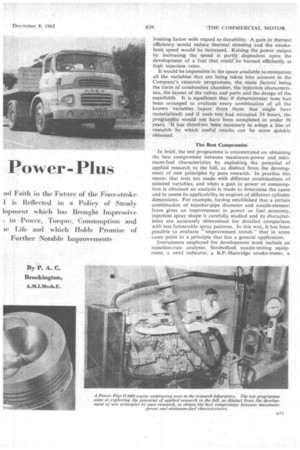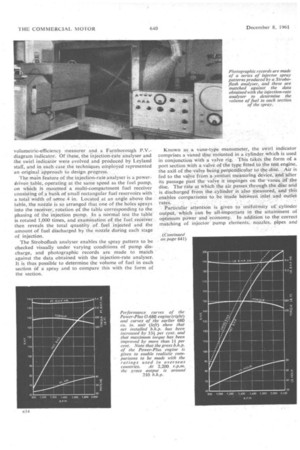Backgrount Power Plus
Page 66

Page 67

Page 68

Page 71

If you've noticed an error in this article please click here to report it so we can fix it.
nd Faith in the Future of the Four-stroke 1 is Reflected in a Policy of Steady lopment which has Brought Impressive in Power, Torque, Consumption and le Life and which Holds Promise of Further Notable Improvements
By P. A. C. Brockington,
A.M.I.Mech.E. " HAT makes me so cocksure that the naturally aspirated four-stroke diesel will dominate p.s.v.
and road-haulage markets for at least 10 years and that the potential of the diesel will remain a commanding factor in the commercial vehicle industry for many years after that?"
To engine technicians, the main highlight of the Public Transport Association Conference at Eastbourne in May was the "cocksure view" of Mr. J. McHugh, Chief Engineer (Vehicles), Leyland Motors, Ltd., that vehicle designers should base their plans on the continuance of the diesel in face of any challenge from other forms of power unit, given that the pattern of world fuel supplies remained substantially unchanged. Mr. McHugh's view has the full backing of the Leyland company and the development programme is being personally supervised by Sir Henry Spurrier, the managing director. It is pertinent that production plans for the next 10 years are based on the manufacture of two "engine envelopes" of the four-stroke naturally aspirated type for the concern's range of engines, and that the workshops are being completely re-tooled to provide a very substantial increase in' production in the immediate future.
Immediately before the last war, the average power output of Leyland engines was 11 b.h.p. per litre. By the end of the war, output had. been increased to about 13.5 b.h.p. per litre and by 1960 the average was approximately 18.4 b.h.p. per litre. In approximately 20 years, therefore, an improvement' has been obtained of over 67 per cent. in the power available, 'and this has been achieved by attention to detail rather than the introduction of any form of " gadgetry.", At the same time outstanding gains have been . made in specific fuel consumption, and the mileage life of the power units between major overhauls has been increased fourfold. • , . . .
. The introduction of the .POwer-Plus range last year marked the outcome of a specific programme of over four yearS of continuous development work aimed at obtaining the maximum benefits from the conventional form of fourstroke engine without resorting to " external aids " such as a supercharger or turbocharger. In the case of the 0.680 200-b.h.p. engine with a rated maximum speed of 2,200 r.p.m., an increase of over 33 per cent, has been derived from rcfining the established design, whilst the 0.600 140b.h.p. economy engine (operating at 1,700 r.p.m.) gives a 12 per cent, improvement, with a highly favourable fuel consumption. Development work is continuing, and it confidently expected that the " ultimate " natura aspirated" engine will be a notable advance on existi designs. It is even considered possible that an engine AA eventually be produced with output-per-litre and power-I weight performance figures equal to those of an up-to-di spark-ignition engine. A number of production-ty engines are operating at a specific fuel consumption of 0. pints/b.h.p.-hr.
, It is notable that the capacity of the crankshaft assembl in the new Leyland engines would permit speed ratings be increased by more than 50 per cent., given that the ft were efficiently burned at the higher speeds. :Thermal stre ing rather than mechanical stressing is the immedil limiting factor with regard to durability. A gain in thermal efficiency would reduce thermal stressing and the smokelimit speed would be increased. Raising the power output by increasing the speed is partly dependent upon the development of a fuel that could. be burned efficiently at high injection rates.
It would be impossible in the space available to enumerate all the variables that are being taken into account in the Company's research programme, the main factors being the form of combustion chamber, the injection characteristics, the layout of the valves and ports and the design of the manifolds. It is significant that if dynamometer tests had been arranged to evaluate every combination of all the known variables (apart from those that might have materialized) and if each test had occupied 24 hours, the programme would not have been completed in under 50 years. It has therefore been necessary to adopt a line of research •by which useful results can be more quickly obtained.
The Best Compromise In brief, the test programme is concentrated on obtaining the best compromise between maximum-power and minimum-fuel characteristics by exploiting the potential of applied research to the full, as distinct from the development of new principles by pure research. In practice this means that tests are made with different combinations of selected variables, and when a gain in power or consumption is obtained an analysis is made to determine the cause and to assess its applicability to engines of different cylinder dimensions. For example, having established that a certain combination of injector-pipe diameter and nozzle-element form gives an improvement in power or fuel economy, injection spray shape is carefully studied and its characteristics are accurately determined for detailed comparison with less favourable spray patterns. In this way, it has been possible to evaluate "improvement trends" that in some cases point to a principle that has a general application.
Instruments employed for development work include an injection-rate analyser, Stroboflash nozzle-testing equipment, a swirl indicator, a B.P.-Hartridge smoke-meter, a
volumetric-efficiency measurer and a Farnborough P.V.diagram indicator. Of these, the injection-rate analyser and the swirl indicator were evolved and produced by Leyland staff, and in each case the techniques eMployed represented an original approach to design progress.• The main feature of the injection rate analyser is a power
driven. table, operating at the same speed as the fuel pump, on which is mounted a multi-compartment fuel receiver consisting of a bank of small rectangular fuel reservoirs with a total width of some 4 in. Located at an angle above the table, the nozzle is so arranged that one of the holes sprays into the receiver, rotation of the table corresponding to the phasing of the injection pump. In a normal test the table is rotated 1,000 times, and examination of the fuel receiver then reveals the total quantityof, fuel injected and the amount of fuel discharged by the nozzle during each stage of injection.
The Strobofiash analyser enables the spray pattern to be checked visually under varying conditions of pump discharge, and photographic records are made to match against the data obtained with the injection-rate analyser. It is thus possible to determine the volume of fuel in each section of a spray and to compare this with the form of the section. Known as a vane-type manometer, the swirl indicator comprises a vaned disc mounted in a Cylinder which is used in conjunction with a valve rig. This takes the form of a port section with a, valve of the type fitted to the test engine, the axi§ of the-vaIve being perpendicular to the disc. Air is fed to the valve from a venturi measuring device, and after its passage past the valve it impinges on the vanes of the disc. The rateat which the air passes through the disc and is discharged from the cylinder is also measured, and this enables comparisons to be made between inlet and outlet rates.
Panic-Oar attention is given to uniformity of cylinder _
output, which Can be all-important in the attainment of optimum power and economy. In addition to the correct matching of injector pump elements, nozzles, pipes and
so on; great care is taken in the machining of the development-engine combustion chambers, the pistons being received from the suppliers in the form of blanks.
Reverting to turbocharging, it is significant that the company have been experimenting since the war with this means of obtaining increased power and that very high outputs have been obtained from turbocharged standard units. Whilst the later development of a turbocharged automotive engine is envisaged as a practical possibility, it is emphasized that evolution of the Power-Plus range indicates the scope of the diesel engine in its naturally aspirated form. Although the single advance represented by the Power-Plus engine is not likely to be repeated overnight, progressive advance may give an even greater proportionate gain. Turbocharger development will remain, therefore, a long-term project with regard to automotive engines, but it is considered that application of turbocharging to industrial engines operating at a constant speed is worth while in the present stage of progress. In such installations it is possible accurately to match turbocharger characteristics to the operating characteristics of the engine, and changing load conditions can be readily accommodated by the turbocharger. It is, therefore, possible to employ a much smaller and more efficient power unit than would otherwise be required.
After experimenting with gas turbines for over 16 years and thorough investigations of various designs evolved in this country and overseas, it is not considered at this stage that units could be produced which were sufficiently economic or durable for commercial-vehicle applications, apart from those in which operating life is very short and fuel consumption is a secondary consideration. Claims for other forms of power unit, including the rotary engine, have also been analysed in detail, and none of these investigations has shaken the faith of the Leyland management or technicians in the future of the four-stroke diesel engine. It is claimed that no alternative type could operate at a comparable thermal efficiency, and this is qualified by the observation that a fuel saving of 10 per cent. is an allimportant economic factor to the majority of users.




































































































































